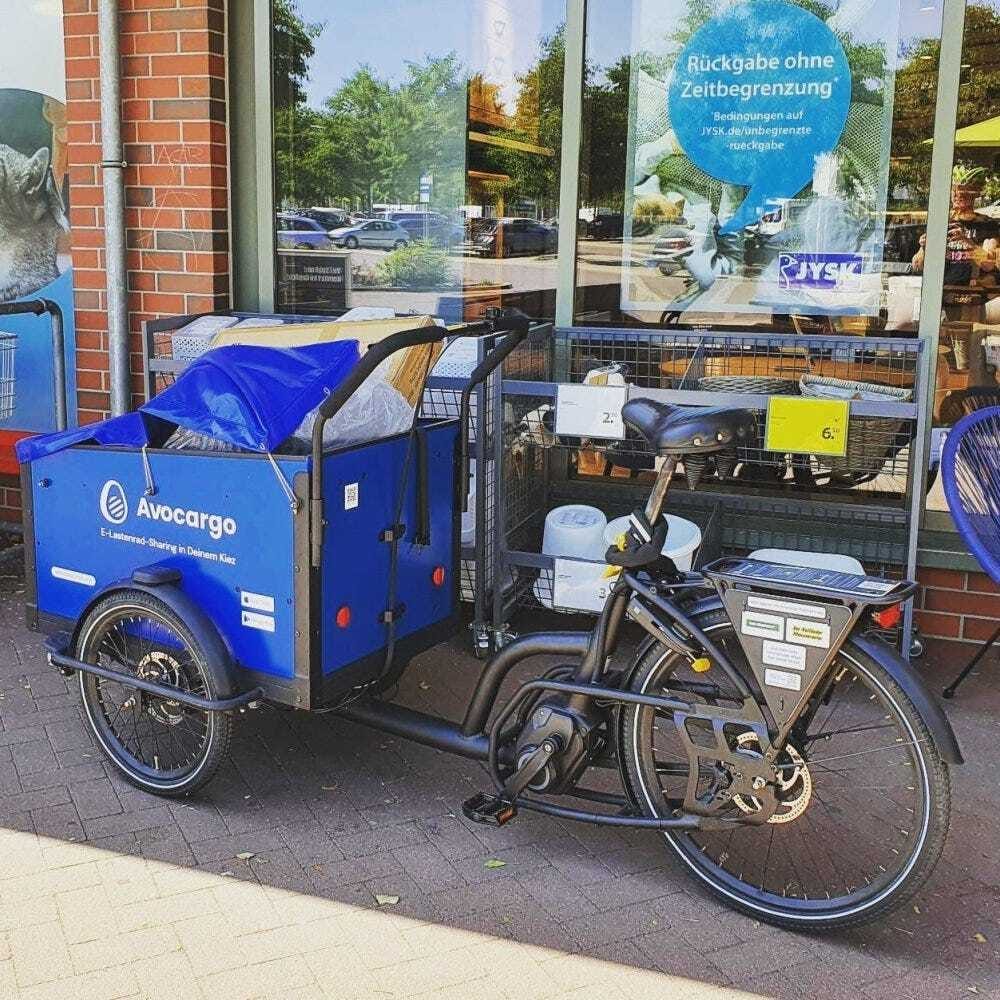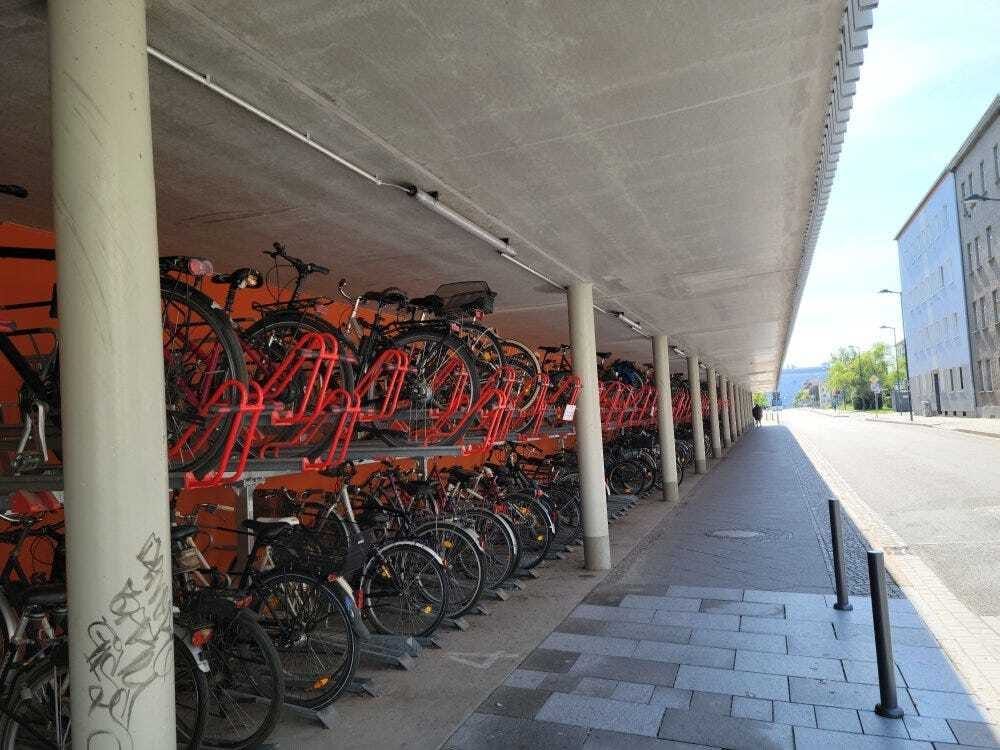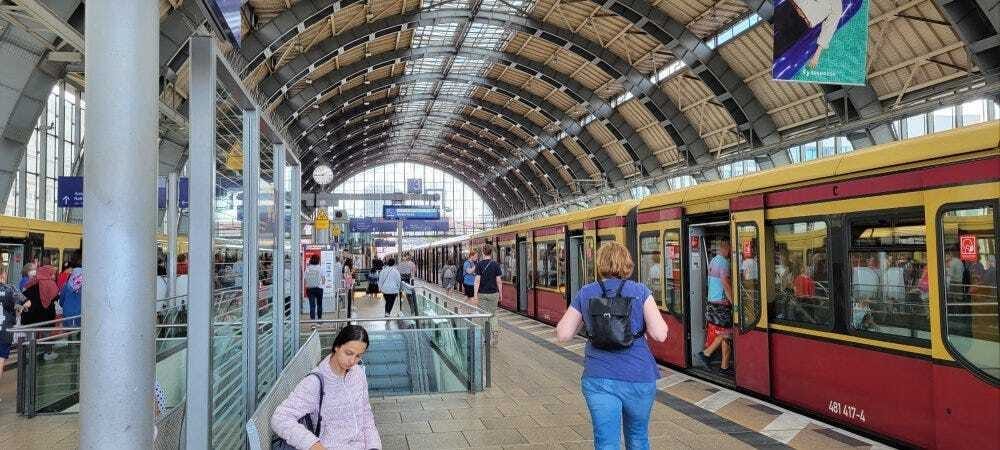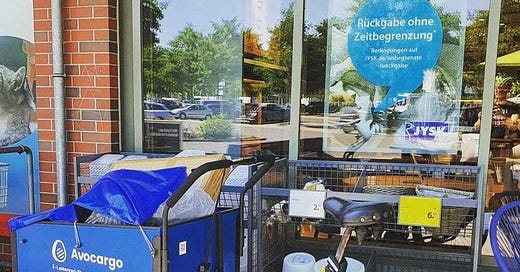Note: This is a repost of an article I originally wrote for the blog version of Alte Frau, New Life in March of 2023. After writing my recent post about Berlin’s bike streets, I realized new readers might be missing some important context. We don’t have a car and get around exclusively by transit, walking or biking. Most Berlin residents don’t own cars, and the variety of transit options here is amazing. I have edited the post for clarity and added notes with updated information.

One of the main benefits of our move has been the ability to give up our cars and walk, bike, or take transit everywhere we need to go.
My kids can easily get to school and extracurricular activities by themselves. (Thank you, Schülerticket!)
Our main grocery store is a five-minute walk, and we live next to two different discount grocers and one health food store.
Our pharmacy is around the corner, and there are numerous restaurants, coffee shops, bakeries, doctors offices, veterinarians, and more within a similar short stroll.
Berlin's neighborhoods are great examples of living in a 15-minute city. an urban planning concept in which all daily necessities and services are within a 15-minute walk or bike ride of where you live.
Even by European standards, Berlin seems exceptionally transit- and pedestrian-friendly. There is both an extensive subway system (U-bahn) and commuter rail system (S-bahn),* which are supported by a larger network of buses and light-rail trams that run around the clock.
In our particilar kiez on the east side of the city, there are three tram lines, a bus line, and three transit stations within a 10-15 minute walk. (Buses and tram stops are right in front of the door.)
Berlin by bike
Berlin is also bike-friendly and getting friendlier. There are bike lanes along almost all major thoroughfares and both the S-bahn and U-bahn have cars designed to accommodate taking your bike along. Berliners of all ages do a lot of their short trips (and some of their long commutes) by bike. For every family I see loading their large double stroller on the tram, there are two or three with young toddlers piloting unbelievably tiny bicycles.
My husband bikes to his office and to client sites all over the city unless the weather is bad. (Yes, I am aware that Germans think there is no such thing as bad weather, 'only bad choice of clothing.' but that doesn't make the streets less slippery.)
During the pandemic, the city created a series of "pop-up" bike lanes to reduce crowding on public transit. Some of these are set to become permanent. And the city recently converted a section of Charlottenstraße (between Leipziger Straße and Unter den Linden) to a bike-only street.

It's not just the inner city with these amenities, either. In my experience, even the neighborhoods outside the ring and the out-lying villages still have good transit access. In many cases, the 'suburbs' - while less dense and more car-centered - have even better bike infrastructure (separated bike lanes, bike-only streets, secured bike parking) than central Berlin.
Everywhere that I've been, I have had multiple different options - different combinations of trains, trams, buses and express buses - to get where I needed to be. That's not even counting the ride-sharing or car-sharing services, and the rental e-scooters and e-bikes that are also available.
There’s an app for that
I use both Google Maps and the BVG app to get around Berlin. When I use the 'Directions' feature on Google Maps, it usually gives me accurate options for the quickest transit routes and then the estimated departure times.
So, for example, if I say I need to go to Alexanderplatz from my apartment, depending on the time I put in the search, it will tell me to take the nearby bus or tram, or whether it is faster to walk to the S-bahn and take the train from there. If I get a response that seems off, I double check with the Trip Planner in the BVG app.
Google Maps will even give you turn-by-turn walking directions, though it is still hard to figure out which exit to take from a train station. BVG app bonus: You can buy transit tickets from within the trip planner, if needed. We all have transit subscriptions, but if I need to travel in the C zone or outside Berlin, this is helpful.
The Deutschland ticket
When we got here last summer, we were really spoiled because the federal states were still sponsoring the 9 Euro Ticket. You could literally go anywhere in the country, on any form of transit - except the ICE, IC, and Eurocity trains - for 9 euros a month.
For comparison, I would normally have to pay 63.42 per month just for Berlin central zones A + B. The Berlin government is currently sponsoring a 29-euro ticket for Berlin AB, so that's what I have. A ticket for all three Berlin zones (ABC) is around 89 euros a month.

The federal government has currently negotiated with all of the federal states for a sucessor to the very popular 9-euro ticket and is supposed to launch the Deutschland Ticket - which would again cover all local and regional transport, except express trains, - for 49 euros.
A lot more than 9, but still a lot less than we would normally pay for just the central part of our one city. The current plan is for the Deutschland Ticket to be available in May, with pre-ordering starting in April.
Update: The 49-euro ticket option was launched in May of 2023. I wrote a detailed post about that here.
Why I love the FMC
Being able to be car-free has been incredibly beneficial for our mental and physical health. If I am cooking dinner and realize I'm missing an ingredient, I can pop next door**and pick up what I need.
The kids can get where they need to go and are already better at navigating the city than I am. They can also walk to the local rec centers, parks and playgrounds (notice the plural) by themselves. Kids stay out late here playing in the evenings, even in really chilly or rainy weather.
I do look things up on Google, but I am just as likely to find whatever I need walking through the neighborhood, whether it's a locksmith, a home goods store, or a hair stylist.
I do not at all miss the stress of traffic, aggressive drivers, searching for parking places and trekking across parking lots to get to almost every activity. This is Germany, though, and there are plenty of cars everywhere. We seem to co-exist just fine. But I cannot for the life of me understand why anyone here would want one.
*Calling them a subway and a commuter train are really over-simplifications. The U-bahn is mostly underground, but not always. The S-bahn is heavy rail that runs on ground-level and underground tracks.
**Except on Sunday, when most stores are closed. This does take some getting used to. I'll probably write a separate post about it.




